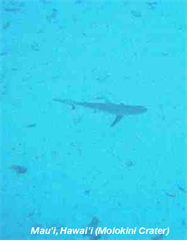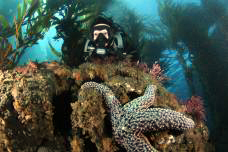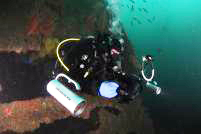 I remember distinctly the very moment when I fell in love with sharks.
I remember distinctly the very moment when I fell in love with sharks.
I was on my first dive trip soon after getting certified and was getting ready for a night dive at Molokini crater (Mau’i, Hawai’i). After jumping into the water carrying a cheap disposable “waterproof” film camera I floated on the surface waiting for the rest of the group. About 70 ft. below were two grey reef sharks circling the reef, as if they were waiting for us to come and visit. I recall very clearly that I was not afraid…at all. I had a real sense of wonder and couldn’t wait to join them. We ended up having several sharks around us during that dive, often only identified by the red glow of their eyes as our dive lights swept around the reef.
Since then I have had the humbling experiences of seeing the magnificent great whites of Guadalupe Island, the awe-inspiring and haunting schools of hammerhead sharks at Cocos Island, and sharing nearly a full day with the gentle beauty Emma, the famous 14 ft. tiger shark who frequents Tiger Beach near the Bahamas. When I plan my dive trips now, there is always one question that is first to be asked…are there sharks to be seen?
This was the question that led me to become active in shark conservation. My wife Liz and I planned a trip to La Paz, Mexico to see schooling hammerhead sharks at the El Bajo pinnacle. We were disappointed and very shocked that not only were there no hammerheads, there were no sharks to be seen at all, none during the entire trip. To find that shark populations had been decimated in the Sea of Cortez, the place Jacques Yves Cousteau called “The World’s Aquarium”, was devastating. We were not only saddened and angry, but highly driven to find out why the sharks were gone and what we could do to stop this from continuing elsewhere.
 I have a unique talent in that I really love to talk in front of groups of people. So I put that talent to work doing public presentations about shark conservation. Dive clubs, civic clubs, educational organizations, anyone and everyone who was willing to listen. Liz and I also worked at public events hosting shark conservation awareness booths. It was not long before we became aware of Shark Savers and their incredible work, and it was not long after that when the relationship resulted in an incredible and very rewarding experience.
I have a unique talent in that I really love to talk in front of groups of people. So I put that talent to work doing public presentations about shark conservation. Dive clubs, civic clubs, educational organizations, anyone and everyone who was willing to listen. Liz and I also worked at public events hosting shark conservation awareness booths. It was not long before we became aware of Shark Savers and their incredible work, and it was not long after that when the relationship resulted in an incredible and very rewarding experience.
In mid-2010, Hawai’i passed the first legislation in the world banning the possession, sale, and trade of shark fins. It was not long after that when we were part of a meeting at the Long Beach SCUBA Show with Stefanie Brendl and Senator Clayton Hee, the two driving forces behind the Hawai’i legislation. Some of the most incredible people I have ever met were at that meeting including Shark Savers’ Mary O’Malley, Shawn Heinrichs, and Stan Waterman. It was that meeting that planted the seed for what would become AB376, the California shark fin ban bill. Liz and I worked along with Sue Chen to represent Shark Savers in the coalition to pass this legislation, which Gov. Brown signed into law in November of 2011. It was incredibly rewarding to be able to see the strong coalition of organizations work so hard to make AB376 a reality.
 I am proud to be part of the Shark Savers organization because they approach conservation with a whole portfolio of programs including creating sanctuaries, working to help enact legislation such as AB376, supporting scientific research such as Sharks Count and the Manta Ray of Hope project, as well as huge amounts of public outreach. They not only have passion, but they back the passion up with solid facts and concrete action with specific goals, and I hope I can continue to help them towards more successes in the future.
I am proud to be part of the Shark Savers organization because they approach conservation with a whole portfolio of programs including creating sanctuaries, working to help enact legislation such as AB376, supporting scientific research such as Sharks Count and the Manta Ray of Hope project, as well as huge amounts of public outreach. They not only have passion, but they back the passion up with solid facts and concrete action with specific goals, and I hope I can continue to help them towards more successes in the future.